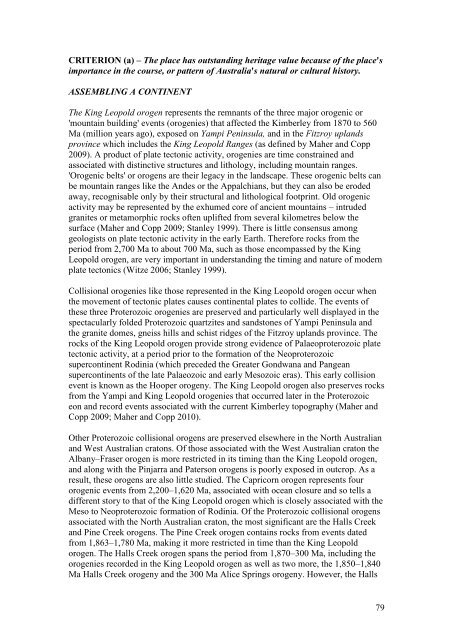WEST KIMBERLEY PLACE REPORT - Department of Sustainability ...
WEST KIMBERLEY PLACE REPORT - Department of Sustainability ...
WEST KIMBERLEY PLACE REPORT - Department of Sustainability ...
You also want an ePaper? Increase the reach of your titles
YUMPU automatically turns print PDFs into web optimized ePapers that Google loves.
CRITERION (a) – The place has outstanding heritage value because <strong>of</strong> the place's<br />
importance in the course, or pattern <strong>of</strong> Australia's natural or cultural history.<br />
ASSEMBLING A CONTINENT<br />
The King Leopold orogen represents the remnants <strong>of</strong> the three major orogenic or<br />
'mountain building' events (orogenies) that affected the Kimberley from 1870 to 560<br />
Ma (million years ago), exposed on Yampi Peninsula, and in the Fitzroy uplands<br />
province which includes the King Leopold Ranges (as defined by Maher and Copp<br />
2009). A product <strong>of</strong> plate tectonic activity, orogenies are time constrained and<br />
associated with distinctive structures and lithology, including mountain ranges.<br />
'Orogenic belts' or orogens are their legacy in the landscape. These orogenic belts can<br />
be mountain ranges like the Andes or the Appalchians, but they can also be eroded<br />
away, recognisable only by their structural and lithological footprint. Old orogenic<br />
activity may be represented by the exhumed core <strong>of</strong> ancient mountains – intruded<br />
granites or metamorphic rocks <strong>of</strong>ten uplifted from several kilometres below the<br />
surface (Maher and Copp 2009; Stanley 1999). There is little consensus among<br />
geologists on plate tectonic activity in the early Earth. Therefore rocks from the<br />
period from 2,700 Ma to about 700 Ma, such as those encompassed by the King<br />
Leopold orogen, are very important in understanding the timing and nature <strong>of</strong> modern<br />
plate tectonics (Witze 2006; Stanley 1999).<br />
Collisional orogenies like those represented in the King Leopold orogen occur when<br />
the movement <strong>of</strong> tectonic plates causes continental plates to collide. The events <strong>of</strong><br />
these three Proterozoic orogenies are preserved and particularly well displayed in the<br />
spectacularly folded Proterozoic quartzites and sandstones <strong>of</strong> Yampi Peninsula and<br />
the granite domes, gneiss hills and schist ridges <strong>of</strong> the Fitzroy uplands province. The<br />
rocks <strong>of</strong> the King Leopold orogen provide strong evidence <strong>of</strong> Palaeoproterozoic plate<br />
tectonic activity, at a period prior to the formation <strong>of</strong> the Neoproterozoic<br />
supercontinent Rodinia (which preceded the Greater Gondwana and Pangean<br />
supercontinents <strong>of</strong> the late Palaeozoic and early Mesozoic eras). This early collision<br />
event is known as the Hooper orogeny. The King Leopold orogen also preserves rocks<br />
from the Yampi and King Leopold orogenies that occurred later in the Proterozoic<br />
eon and record events associated with the current Kimberley topography (Maher and<br />
Copp 2009; Maher and Copp 2010).<br />
Other Proterozoic collisional orogens are preserved elsewhere in the North Australian<br />
and West Australian cratons. Of those associated with the West Australian craton the<br />
Albany–Fraser orogen is more restricted in its timing than the King Leopold orogen,<br />
and along with the Pinjarra and Paterson orogens is poorly exposed in outcrop. As a<br />
result, these orogens are also little studied. The Capricorn orogen represents four<br />
orogenic events from 2,200–1,620 Ma, associated with ocean closure and so tells a<br />
different story to that <strong>of</strong> the King Leopold orogen which is closely associated with the<br />
Meso to Neoproterozoic formation <strong>of</strong> Rodinia. Of the Proterozoic collisional orogens<br />
associated with the North Australian craton, the most significant are the Halls Creek<br />
and Pine Creek orogens. The Pine Creek orogen contains rocks from events dated<br />
from 1,863–1,780 Ma, making it more restricted in time than the King Leopold<br />
orogen. The Halls Creek orogen spans the period from 1,870–300 Ma, including the<br />
orogenies recorded in the King Leopold orogen as well as two more, the 1,850–1,840<br />
Ma Halls Creek orogeny and the 300 Ma Alice Springs orogeny. However, the Halls<br />
79
















